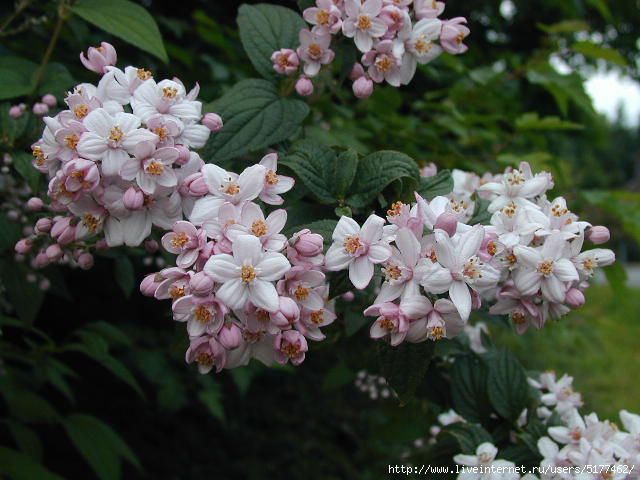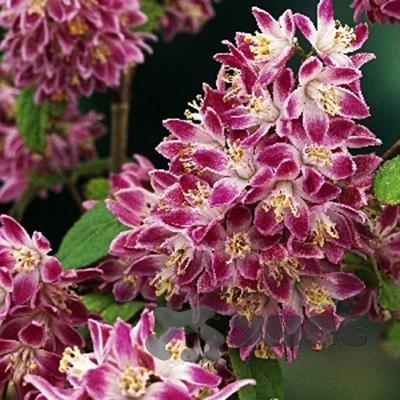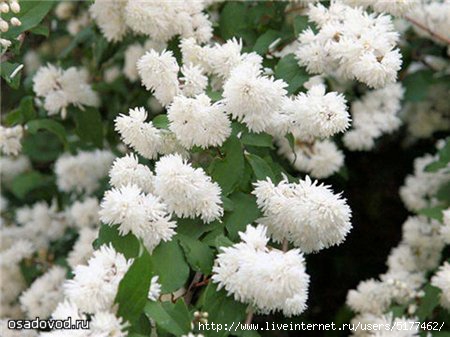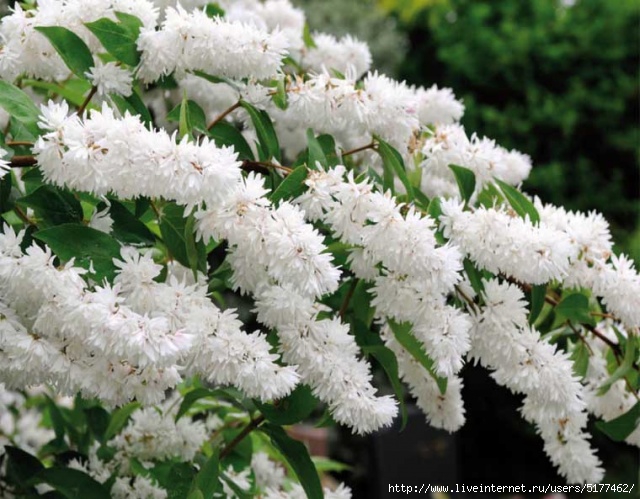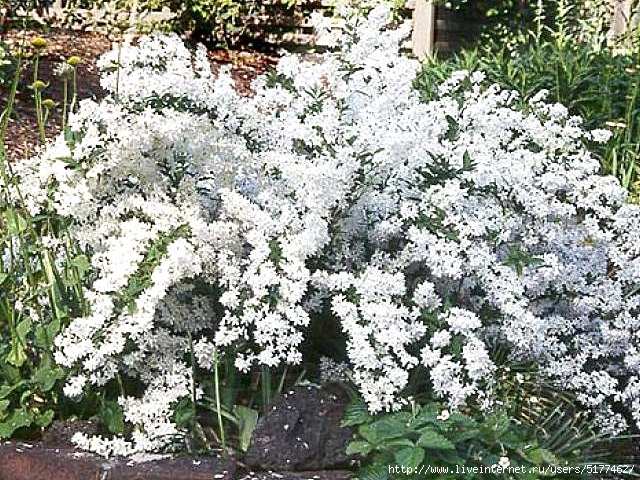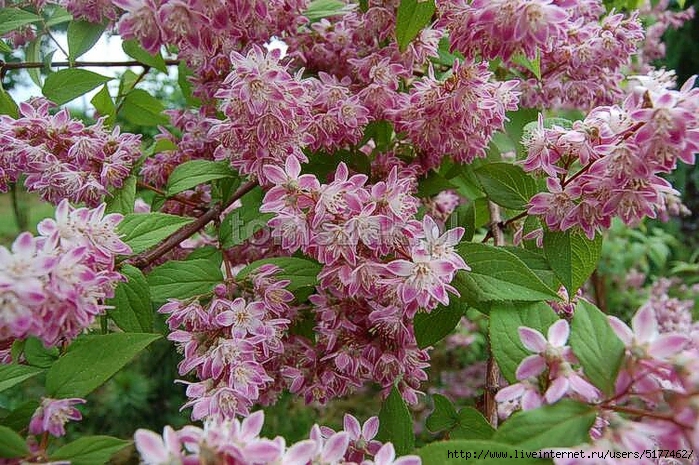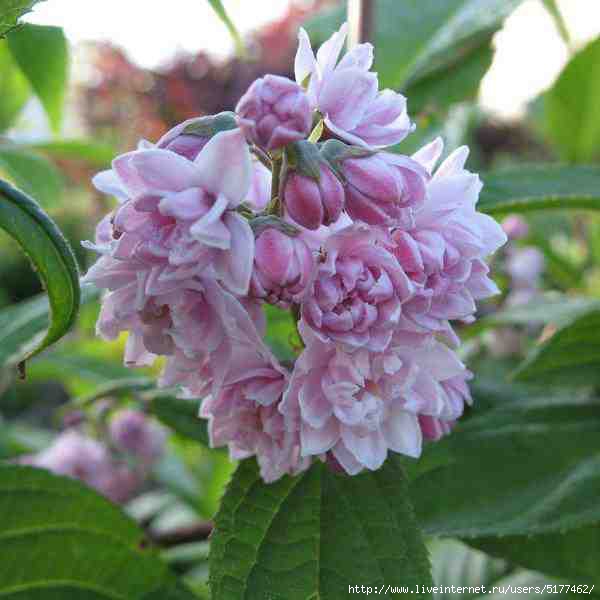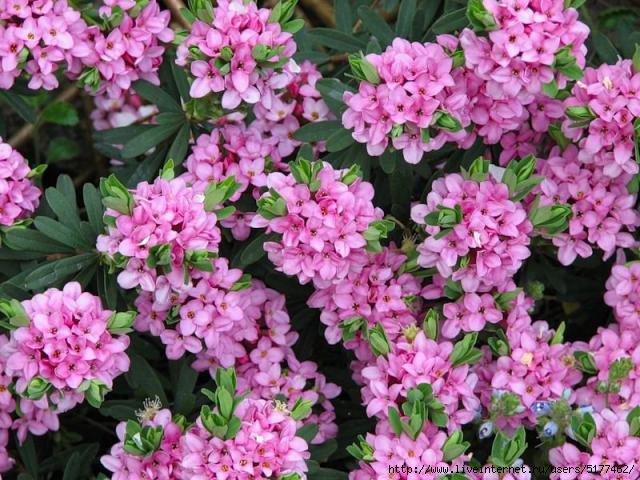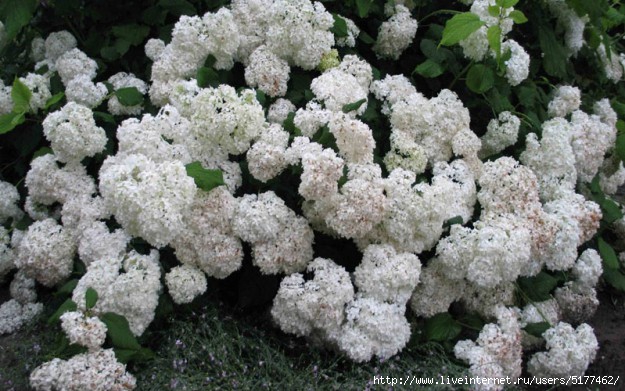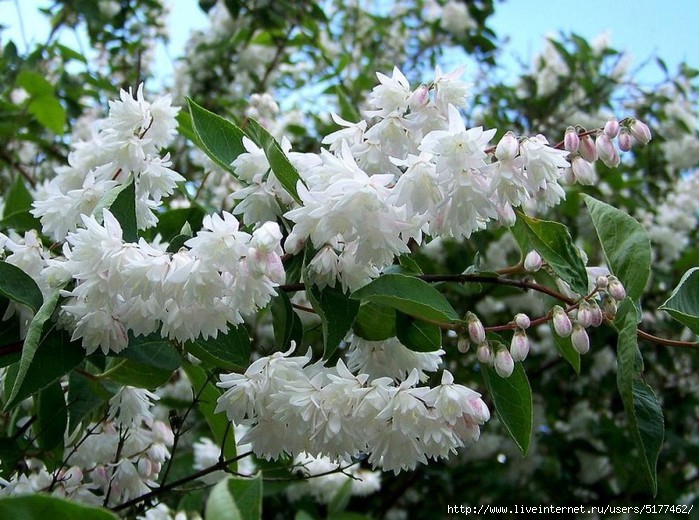Action pink. Deytsia is an Asian beauty. The species composition of the shrub
Action today is especially popular among plants that are used in landscape design. This evergreen shrub belonging to the hydrangea family, has a very attractive appearance and will become a real decoration of any suburban area. Let us consider in more detail the description of the action, as well as some recommendations for caring for this culture.

In the wild, these shrubs are found on the territory of the South-Eastern and East Asia and occasionally in North America. To date, there are quite a few varieties of this plant. Moreover, among them there are both erect and sprawling species. There are some wild-growing specimens that reach a height of 35 m. The stems of this shrub cover whole simple green leaves. If the plant is not rejuvenated and not transplanted, then it can live for about 20 years.
Of all the advantages of this culture, it is worth noting the long and rich flowering. Buds begin to form in late spring or the first months of summer. This parameter largely depends on the climate of a particular region of growth. Typically, these shrubs begin to bloom about 2-3 weeks after the snow has completely melted from the soil. The flowers are white, but can also be pink or purple. However, they are mostly odorless. When the bush fades, boxes are tied in which the seeds ripen. In general, this plant can be propagated by cuttings or seeds. Still sometimes layering or root offspring are used to germinate this crop.
Action: landing
These plants, as mentioned above, can propagate using small cuttings 80-90 mm long. Planting is best in May or June. To do this, seedlings or soft shoots are first placed in a mixture of sand or sandy peat. After some time, they are transferred to the greenhouse.
Young plants, before being planted, are placed in a container with soil in a greenhouse. In this case, the roots need to be pinched a little to make the bush more magnificent. After about two years, the action bush is transplanted to its permanent place. For best results, place the plant in slightly moist, loamy soil. The soil needs to be fertilized. To do this, rotted manure is placed above the roots. Further, it is necessary to periodically fertilize. When this is done, it can be considered that the landing is completed. It remains to organize the proper care of the shrub. Without it, the bush will not produce beautiful flowers, which are so important for the decor of the site. As you can see, growing action is not a very difficult task.
plant varieties
Today there is a large number of action varieties. Let's look at just a few of them below:
- Action pink. On deciduous bushes of this variety, pink or white oblong flowers grow. The main flowering occurs at the end of spring or summer. It is worth noting that this variety feels good in partial shade. He is not very demanding on water - he has enough watering of an average level. This variety tolerates drought well. It has the best view in spring and summer. For normal growth of this variety, soil with an acidity of pH 5 to PH 8 is required. The crop grows best in fertile soil. The bush has a rounded shape and can grow up to 1 m. The maximum growth is achieved only after 6-9 years. The main method of propagation of this variety is cuttings. It is noteworthy that the leaves, which have a pointed shape, do not lose color even in winter.
- The action is whiter. Snow-white inflorescences of this variety in diameter can reach 3 cm. It blooms actively in mid-summer - from June to July. If all conditions for care are observed, then the beautiful appearance of the plant will be preserved for quite a long time, namely from 20 to 25 years. In height, the bushes of this variety can reach up to 2 meters.
- The action is graceful. Bushes of this variety have slender arched stems and simple leaves. The bush blooms with white flowers, usually in the spring and summer. Flowering begins in April or May. At the same time, snow-white flowers appear on the bush. Japan is considered the homeland of this variety, where it blooms in April-May. Bushes with oval greenish-brown leaves can grow up to 1.8 m. The lower surface of the leaves is almost snow-white. It is worth noting that this variety is not picky about the acidity of the soil. In addition, the plant is resistant to many diseases and pests. However, sometimes it is still affected by aphids, which causes the leaves to become spotty. There is a possibility that some branches of the plant will dry out, this will spoil the appearance of the bush.
- The action is magnificent (or the action is hybrid). This variety is a hybrid plant from deutia rough and deutsia vilmorena. These bushes can grow up to 2.4 m. The weight of many pinkish-white inflorescences is quite large, so the branches of the shrub often fall to the ground. It is also worth noting that this variety prefers to grow in the shade. For example, this culture will feel good under the crown of a tree. In order for the beautiful appearance to fully reveal, the plant needs a sufficient level of humidity and good lighting. Remember that when planting this bush, it is necessary to prepare high-quality drainage. After all, the plant does not like excess salt and moisture in the soil.
- Action Turbillon Rouge Bushes of this variety, reaching a height of up to 1.6 m, have pale red and white flowers with yellow stalks and five petals forming a beautiful bowl or star shape. During flowering, which occurs more often in the middle and until the end of summer, they have a pleasant and persistent aroma. It should be noted that peeling of the bark is possible on the most mature plants. The culture usually blooms in early June. Like other varieties, after flowering, the bush is cut off. In this case, the shoots are cut from 1/4 of the soil level.
- Action mont rose. Bushes of this variety are of medium size. On the stems grow oval-shaped leaves and inflorescences in the form of a cone. Culture tolerates dry periods well. Flowers of this variety are valued for their unpretentiousness and durability.
- The action is terry. The name of this plant was due to its double flowers. The bush can grow up to 1.6-2 m. Abundant flowering mainly occurs during May-June. When a large number of flowers bloom, the stems of the plant bend. It should be noted the beautiful star-shaped inflorescences - they are the most attractive part of the bush.
Action: care
Care for action is very important. So, with the right approach, you can get decorative material to implement the ideas of landscape designers. In particular, shrubs are used for planting hedges. In addition, they are often used to create garden compositions, sculptures.
Step-by-step procedure for planting and caring for a crop:
- Before planting an action, it is important to choose a place for landing and perform the necessary marking of the selected area. There should be at least 250 mm between adjacent bushes. This space is enough for the shoots of the plant to develop properly and grow leaves.
- It is best to plant a plant in an open area, which is lit by the sun in sufficient quantities. For planting, a hole is dug about 450 mm deep, after which it is filled with humus (2 parts), peat (1 part) and sand (2 parts). At the same time, at least 2.4 m must be maintained between adjacent shoots. It is important that the neck of the root, after filling the soil, is at the same level with it.
- In order for the flowering to be lush, the soil needs to be fertilized periodically (once a week). To feed the roots, you can take any organic fertilizer. It is important that they are diluted in water (9 parts water, 1 part fertilizer). At the same time, 5-6 liters of diluted fertilizers should be applied to each bush. In general, all activities that stimulate the growth of this crop should be carried out only during the flowering period.
- Regularly after the next pruning, it is necessary to introduce mineral top dressing into the soil.
- As for the care of the flowers of this plant, the most important thing in it is to properly organize watering. So, during growth, watering should be no more than a couple of times a month. Moreover, about 9 liters of water should be poured onto one bush each time.
- If the summer turned out to be rather dry and hot, then watering should be done twice as often. Moreover, the amount of water per bush also doubles - it will take up to 18 liters. After watering, it is recommended to loosen the soil well.
- From mid-August, it is recommended to stop watering. In early autumn, when heavy rains are not uncommon, it is recommended to cover each bush with a suitable waterproof material. When the plant fades, it should be cut and wrapped to prepare for wintering.
The shrub does not require special care. Therefore, it is able to endure any climate conditions, even the presence of smoke and gas in the air. This plant is quite resistant to the vagaries of the weather, but, nevertheless, warm and sunny weather will be the best condition for it. Sometimes at low temperatures in winter, the branches of the bush can partially freeze out. However, this is not so scary for them, because even after freezing, the shoots are able to grow again. Moreover, the plant in the same year will again delight with flowers.
Trimming action must be performed in without fail twice a year, namely, in spring and autumn. When the plant has faded, the branches must be cut. This must be done before the first strong kidney. Although sometimes cut right to the base. Old shoots are sometimes cut out from the shrub. It is also allowed to cut branches that make the bush too thick. Next to the shrub, it is necessary to weed the weeds and loosen the ground. Moreover, it is desirable to do this at a depth of up to 250 mm.
Flowering shrubs occur on last year's shoots. Therefore, they must be preserved throughout the winter period. Otherwise, the bush will not please with beautiful flowers. If there is a lot of snow in your area during the winter, you can bend the branches to the ground, which increases the chances of keeping the shoots in the cold winter. In some regions, frosts often occur even when there is no snow. Under such conditions, the bushes of young plants of action can only be covered with a frame, which is then filled with dry branches of spruce or pine. Next, the upper part must be wrapped with a film.
As for older plants, a different method is usually used for them. So, in order to save the bush, you need to tie it with any airtight material.
Application in garden design
Since there are several varieties of action, you can make the design of the site very bright and varied. This will require minimal cash outlay. Due to the variety of forms and beautiful appearance, deytion bushes are widely used in landscaping. For example, undersized varieties are successfully used as border plants. Higher species are well suited not only for single plantings, but also for creating small compositions. In addition, they have proven themselves as the basis for garden sculptures.
This culture is often used for site decoration because it is quite resistant to urban conditions, where not all ornamental plants can take root. In order for the action bushes not to lose their attractiveness, their correct pruning after flowering is important. The decorative value of these plants is also related to the fact that they bloom profusely for a long period. In addition, the flowers themselves differ from others in their elegance, which gives the plantings an amazing beauty.
This plant is in recent times becoming increasingly popular with many gardeners. For decorative purposes, it is used very often, like hydrangeas, and lilacs. Low-growing varieties are actively used to create decorative compositions. These plants are planted against the background of decorative coniferous crops to make the composition more exotic. Tall varieties of action in mild climates are successfully used to create hedges. It is worth noting that this plant is practically immune to smoke. Therefore, it is often planted in front of high-rise buildings in cities, even if the plots are located next to the road.
Shrub action: photo
Luxurious action considered to be one of the most beautiful flowering shrubs. Not so long ago, having appeared in our gardens, she immediately won the hearts of garden design lovers.
White, pink or purple action flowers bloom in such huge numbers that they give the impression of a snow-covered bush.
To enjoy this charming sight in your own garden, you need quite a bit - plant a seedling correctly and regularly care for the plant.
Action - perfect grace and beauty
action, Deutzia is a flowering shrub from the extensive Hydrangea family. The genus includes 50 deciduous or evergreen species native to East and Southeast Asia. Some species can also be found in Mexico.
luxury plant first described by the botanist Thunberg in the 19th century, having discovered it while traveling in Japan.
And the title its action was in honor of the Dutch merchant Johann van Deutz, who financed the botanical expedition. In Europe, the plant appeared at the end of the 19th century.
bewitching beauty action made it a very popular plant for landscape design. During flowering, the shrub is unusually beautiful.
lush bush densely strewn with delicate snow-white or pink flowers, collected in racemose or corymbose inflorescences. All this flowering splendor gives the garden plot a unique charm.
By shape action can be sprawling or erect, and its height varies from 50 cm to 4 m. Opposite emerald green leaves, densely covering the stems, have a simple, integral shape with serrated edges. The life expectancy of the plant is about 25 years.
Action flowers bloom on the tops of last year's shoots, the tips of which are prone to freezing during wintering.
However, the plant has a remarkable property - annual shoots, seized by frost, with the onset of warm days grow very quickly and tie flower buds at the right time. Flowering, depending on the species, lasts from May to July or from June to July for two months.
Action types
Actions are of the following types.
Action small-flowered or Amur, Deutzia amurensis is the most frost-resistant species with a spreading form up to 2 m in height. Snow-white flowers are collected in small corymbose inflorescences. The plant begins to bloom in June.
Action graceful, Deutzia gracilis is a meter-high shrub strewn with paniculate inflorescences about 10 cm long, consisting of delicate white flowers. Differs in early and very lush flowering.
Deutzia Lemoine, Deutzia x lemoinei is a meter tall hybrid obtained by crossing deutzia graceful and amur. It blooms with snow-white flowers, collected in pyramidal inflorescences. Arched shoots are covered with gray-green foliage, which turns yellow, pink and red in autumn.
Action stellate or rough, Deutzia scabra - an interesting species, reaching 2.5 m in height, with a rough surface of leaves, pubescent with small hairs. White flowers are collected in narrow paniculate inflorescences up to 12 cm long. It begins to bloom later than other species - in the second half of July.
On the basis of the rough action, very showy varieties:
- Plena - double white-pink flowers;
- Candidissima - snow-white double flowers;
- Roseo-plena - the most frost-resistant variety with pink double flowers;
- Marmorata is a decorative deciduous variety with leaves covered with small yellow spots;
- Punctata - a form with small white speckles on the leaves.
Deytion longifolia, Deutzia longifolia - shrub up to 2 m high with large pink-lilac flowers. The elongated, serrated leaves are pubescent on the reverse side. This species has varieties with pale pink and purple flowers.
landing action
Most often action appears on the site in the form of a seedling, which is purchased at the garden center. When buying a seedling, you should carefully examine the plant and find out if it is damaged and if the buds are intact. In this case, it is desirable to give preference to a seedling with an open root system in order to be able to better assess its condition.
If the roots of the seedling overdried, before planting, you need to soak them for a couple of hours in a weak solution of potassium permanganate, and then dip them in a clay mash. Broken branches must be cut off, and it is advisable to shorten too long roots to 40 cm.
best time for planting the plant is spring. Landing work begins with the choice of a place. Deytion prefers to grow in well-lit places, but with diffused light. Ideal plot in a semi-shady garden under the crowns tall trees.
plant a shrub best on the south side of buildings or in places protected from cold winds. In this case, the action should be located at a distance of at least 2.5 meters from other plants and objects, because the bush is actively growing in breadth.
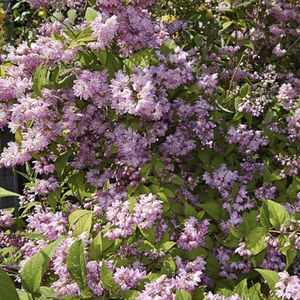 Action needs in fertile and well-drained soil with moderate moisture. close occurrence ground water plant is unacceptable. For the landing pit should be prepared fertile mixture, consisting of:
Action needs in fertile and well-drained soil with moderate moisture. close occurrence ground water plant is unacceptable. For the landing pit should be prepared fertile mixture, consisting of:
- 1 part of peat compost;
- 2 parts of humus;
- 2 parts sand;
- 100 g of nitrophoska;
- 300 g of slaked lime or a glass of wood ash (with increased soil acidity).
They plant action in the following way:
- dig a landing hole from 40 to 50 cm deep and about 60 cm in diameter. Then a drainage in the form of sand is placed on the bottom with a layer of about 15 cm;
- lower the roots of the seedling into the pit, straighten them and fall asleep with the prepared earthen mixture. In this case, it is important to ensure that the root neck is 1 or 2 cm below ground level;
- then they tamp and shed the earth, and also shorten the shoots of the plant, leaving 3 to 5 buds on each;
- the ground around the bush is mulched with peat, the layer thickness of which should be at least 5 cm.
Features of care
action does not need frequent watering. A bucket of water is enough for a plant for a week. In dry weather, the volume of water for irrigation increases to 2-3 buckets per bush. At the same time, it is important to ensure that the earth around the shrub is wetted to a depth of at least half a meter. In the second half of August, watering stops altogether.
At the same time as watering loosening of the soil to a depth of 25 cm and removal of weeds are carried out. Mulching the trunk circle will greatly facilitate this procedure.
Action responds well for mineral and organic fertilizers. During the season, it is fertilized monthly with liquid manure in a ratio of 1:10 - from 4 to 5 liters per bush. During flowering, the plant is fed twice with complex mineral fertilizer - from 100 to 150 g per adult plant.
pruning
Action is growing fast, therefore, it needs annual pruning - in spring and after flowering. In the spring, sanitary pruning is done. Broken, diseased and old branches are removed, frozen shoots are shortened. Old branches can be cut at the root so that new ones grow in their place.
After the end of flowering faded shoots are cut to a strong bud or to the base. Also thin out the bush and cut out diseased shoots. At the same time, the formation of the crown is carried out.
After trimming it is useful to feed the action with organic fertilizer.
Shelter for the winter
Most varieties action does not differ in frost resistance, therefore, for the winter, the bush must be insulated. The trunk circle is mulched with straw or fallen leaves. Small bushes can be covered with wooden boxes or cardboard boxes, and insulated from above with coniferous spruce branches.
tall species the actions are tied, wrapped with thick paper or burlap, and wrapped with covering material in several layers on top.
reproduction
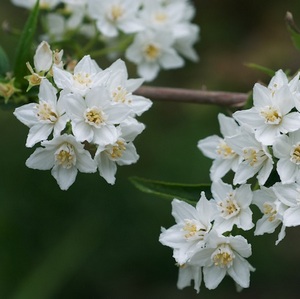 By dividing the bush. An adult overgrown shrub is dug up and divided into 2 or 3 parts along with the roots. Immediately, without letting them dry out, the plants are planted in a new prepared place.
By dividing the bush. An adult overgrown shrub is dug up and divided into 2 or 3 parts along with the roots. Immediately, without letting them dry out, the plants are planted in a new prepared place.
spring bushes give root shoots, which are carefully dug out and also transplanted.
Green cuttings. In early June, cuttings about 15 cm long are cut from developed shoots. In this case, the lower cut is made obliquely under the internode.
Leaf blades cut in half with scissors or secateurs. Next, the cuttings are treated with "Kornevin" and rooted in nutrient soil, half mixed with coarse sand. Also, sand is poured in a layer of about 3 cm on top of the soil.
The cuttings are placed obliquely into the ground and bury them half a centimeter deep. The container with seedlings is covered with polyethylene. With regular watering and airing, the cuttings, as a rule, take root by mid-September, after which they are added dropwise to garden plot, insulated for the winter with coniferous spruce branches. In the spring, the plants are transplanted to a permanent place.
lignified cuttings. In late autumn, cuttings are cut from lignified shoots, each of which has 3-5 buds, from 15 to 25 cm long. Up to 15 cuttings collected in bunches are tied together, placed in moistened sand, almost completely falling asleep, and stored until spring in a dark place at zero temperature. In the spring they are rooted in the same way as the green cuttings.
seeds. Ripe seeds of the plant in October are removed from the seed pods, dried and stored until spring. Small seeds are sown superficially in an earthen mixture of equal parts river sand, peat and humus, lightly powdering them with a thin layer of sand.
Capacity with crops covered with foil or glass. With regular airing and moistening from the sprayer, seedlings, as a rule, appear within one and a half months. After the seedlings have well developed leaves, you can plant them in the garden.
Pests and diseases
Action is stable to diseases and pests. However, sometimes she is attacked bumblebee proboscis who loves to eat the leaves of the plant. The treatment of the bush with a solution of "Karbofos" or "Ftalofos" will help get rid of the voracious insect.
Be sure to put a luxurious beauty in your garden action! Providing it with proper care and warming for the winter, you will be able to admire the enchanting beauty of this extraordinary plant for many years.
And for the most curious, we suggest that you familiarize yourself with the video about the action
Action is a genus perennial shrubs from the Hortensia family, from 50 cm to 4 m high, among 72 species there are both deciduous and evergreen. It is valued by gardeners for its long (up to 35 days) and very abundant flowering in late spring - early summer, as well as for the shape of the bush - in most species it looks like a dome, slightly less in width than in height.
This plant lives for about 25 years. Flowers are white, pink, sometimes red, simple or double, mostly odorless. It is often used as a hedge, because it calmly tolerates smoke, or as freestanding bushes. Even fragrant species are absolutely safe for people with allergies. In green form, not in the flowering period, the action is easily confused with honeysuckle.
The most common types and varieties

Growing conditions and care
Action is a very demanding plant, and in order for it to live long and be beautiful, provide it with the following conditions:
- Lighting and air humidity ideal for action in partial shade from tall trees with an openwork crown. Such neighbors will protect the bushes from direct sunlight, but leave a sufficient level of lighting and keep moisture in the air. If there is no possibility of such a neighborhood, it is better to choose the sun than a thick shadow.
- North cold wind and draft are also undesirable for the action, so it is better to look for a place for it in the south of the house or other building.
- ground water located very close to the surface of the earth will also not allow the development of action for a long time and fully.
- When choosing a place for an action, also consider its possible dimensions after 5-7 years: it is better that nothing grows within a radius of 1-2.5 m (depending on the variety and how you cut it).
- soil they prefer fertile, it can be loamy, but drained, because. This plant does not tolerate stagnant moisture in the ground. The ideal mixture for mature plants is a combination of humus, river sand and peat (or compost) in a ratio of 2:2:1. Acidity is desirable neutral (pH 5 - 8).
- Watering produce regularly from April-May to mid-August, an average of 10 liters per plant once a week, and in dry hot weather - 20 liters each. large bushes and hedge watered at the rate of 30 - 40l per 1m. sq.
- loosening carried out after watering to a depth of 20 - 25 cm, simultaneously removing weeds. Mulching the root circle will help to avoid this procedure.
- pruning carried out twice a year: in spring and summer, after flowering. In the spring, only a sanitary haircut is carried out - frozen and dry branches are removed, as well as broken and crushed ones. The main pruning is carried out immediately after flowering, so that the plant has time to recover. To do this, all shoots are shortened by 1/3, simultaneously adjusting the shape of the bush. If you are categorically not satisfied with the shape of your action, feel free to cut it to the ground, leaving only a stump. This stimulates the active growth of basal shoots, and the next year you will receive a new lush bush.
- Feed up the action is plentiful when planting, and then only during the flowering period 1 time per month, 3-4 liters of liquid manure per plant. Additionally, it is desirable to feed 2 times a season with a complex mineral fertilizer of 100 - 150g per 1 bush.
- Shelter for the winter required for different varieties and regions.
- It is enough for frost-resistant varieties to mulch the root circle with fallen leaves, straw or spruce branches.
- If the plant is an adult, with upright shoots, tie its branches with twine or twine, and wrap it with covering material on top - burlap, spandbond or lutrasil.
- Juveniles and bushes with a round crown can be bent to the ground, a frame can be built above them, covered with spruce branches or fallen leaves, covered with lutrasil, and the last layer is a film.

Don't forget to remove the shelter at the beginning of April so that the action will bloom in time.
Planting and reproduction
Young actions are planted only in early spring, when the buds have not yet blossomed on the trees. To do this, prepare holes 35-60 cm deep (the poorer the soil, the deeper) at a distance of 1.5 m from each other. If the plant is 1 - 3 years old, pinch the roots for greater bushiness. I drain the bottom of the pit with sand or broken bricks, a seedling is placed on it, the roots are straightened horizontally and covered with suitable soil (see growing conditions and care). Fertilizers are mixed into the soil: about 10 liters of compost and 100 g of nitrophoska per 1 plant. The root neck can be deepened by no more than 2 cm. The root circle is mulched with peat, a layer of about 5 cm.
The action is propagated most easily by cuttings (about 90% take root) or root sprays, but reproduction by seeds, division of the bush and layering is also possible.
- Green cuttings are cut in May-June. To do this, cut 8 - 10 cm from large, mature shoots. The cut will not be superfluous to process with a root formation stimulator. For a soil mixture, equally nutritious soil (for example, sandy peat) is combined with river sand. The cuttings are deepened by 0.5 cm with a slight slope and sprinkled with a 2-3 cm layer of sand. Seedlings are ready for planting in a permanent place only after 2 years.
- Lignified cuttings are harvested in late autumn, during the dormant period of the plant. Cut cuttings of 15 - 25 cm, 3 - 5 buds on each, tied into a bundle of 10 - 15 pieces and vertically, almost completely covered with wet sand. Stored until spring in the basement, and then grown in the same way as green cuttings.
- The bush is also divided only in the spring. To do this, it is completely dug up, old branches are removed, thinned out and divided into 2 - 3 parts. Transplant as quickly as possible so that the roots do not have time to dry out.
- Root offspring can be separated without digging out the entire bush, and also quickly transplanted into a prepared hole.
- The seeds of the action ripen in October in fruits - boxes, they are crushed and stored until spring. Seeds are sown in light fertile soil (peat, humus and river sand in equal proportions), superficially, and sprinkled on top with a thin layer of clean sand. Crops are well moistened and covered with glass or a transparent film. Seedlings should be expected in 1 - 1.5 months. Young growth dive with well-developed leaves immediately into open ground.
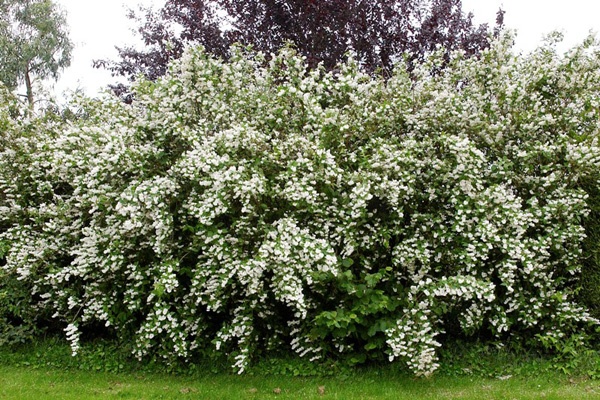
Diseases and pests
Deitia is a very disease resistant plant, but occasionally it can be affected by aphids and leaf spot. And if suddenly the leaves of your bush are eaten by a bumblebee proboscis, treat it with a 15% solution of phthalofos or karbofos.
Deutia shrub is a genus with 60 species of flowering plants in the Hydrangea family. The natural habitat of this genus is eastern and central Asia (from the Himalayas east to Japan and the Philippines), central America and Europe. Also, a huge number of plant species are observed in China (about 50 varieties).
Deutzium flowers are named after the 18th century Dutch patron and botanist Johann von der Deutz.
The deytion shrub is a fairly new plant for modern gardens, with the only exception being the action scabra, which was seen in Japanese gardens by Enegelbert Kampfer and Carl Peter Thunberg. But in fact, for the first time this flower appeared in Europe only after 1830, and two or three species noted in the Royal Horticultural Society were collected from wildlife only during the 20th century.
Deutia shrub is grown as ornamental plant thanks to its pink and white flowers. Many cultivars and hybrids are also used for gardening, including double-flowered varieties: for example, Deutia citricum is a hybrid of Deutia gracilica and Deutia parviflora. Creating hybrids allows gardeners to reap big benefits - for example, one species with drought tolerance and even more fragrant flowers. Sometimes, without a thorough study, it is very difficult to understand which particular family a particular variety or hybrid belongs to. We bring to your attention a photo of the action and detailed description the process of planting and care during the cultivation process. In addition, descriptions of the most popular varieties of action are offered, such as white and pink, hybrid and terry, wooly, strawberry and pink pom pom.
Deuterium flowers are often used as a border plant due to their height. Some varieties of deutsia are recommended for ground cover, for rock gardens, or simply for growing in containers and pots. 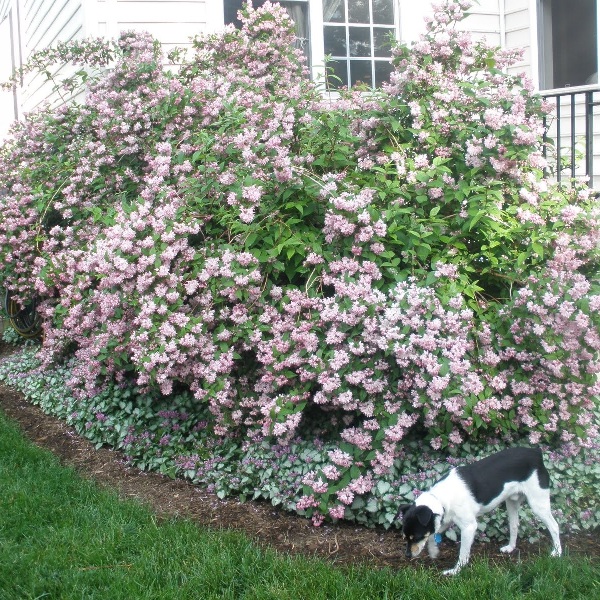
Description of the action and its photo
Deutsia is mainly a shrub, with a height of one to four meters. Most of them are deciduous, but some subtropical varieties can be evergreen. The leaves are opposite and with serrated edges. Look at the photo shrub action in the variety of varieties presented: 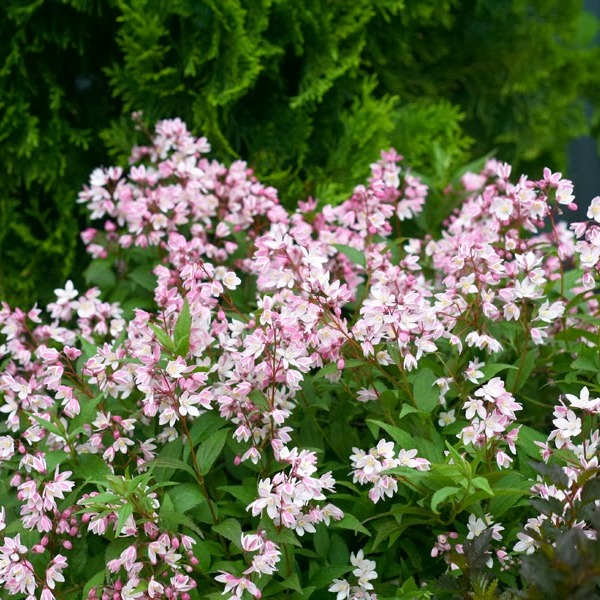
Action flowers grow in the form of a panicle or shield. The flowers are mostly white, but some varieties can be pink and red. They can be single with five petals or double with more petals. They grow in loose clusters and bloom from late spring to early summer. The action is good because it does not cause allergies.
Shrubs that have shredded bark produce small fruits in the form of a dry capsule containing numerous small seeds. Recognizing the species is very difficult, often requiring knowledge of microscopic details such as leaf structure and seed capsule structure.
A non-flowering plant is easily confused with a honeysuckle bush. 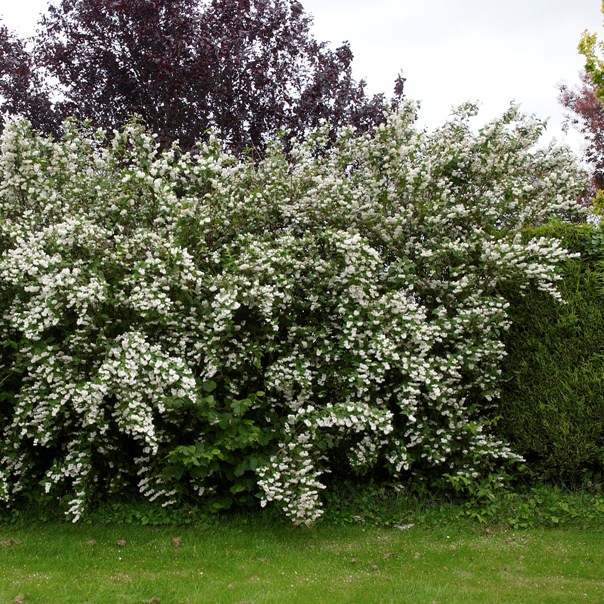
Shrub care action
Many varieties of action do not tolerate winter cold, so the plant should be placed in a room well protected from drafts and frost. The deitia plant is very tolerant of different types of soil and water conditions when cared for. But all when caring for a flower, it is worth making sure that it is grown in the sun in moist, but well-drained soil with humus with neutral acidity. It is not forbidden to plant the action in partial shade, but you should know that there will be much fewer flowers than when in the open sun. When organizing the care of a bush, action should follow the rule of providing scattered sunlight throughout the daylight hours.
As a rule, the plant is not vulnerable to various diseases and pests. 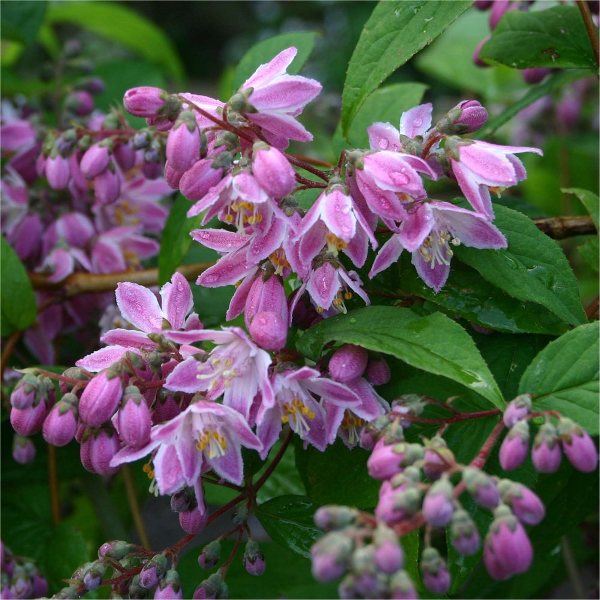
Action maintenance includes a pruning process, as all species grow on woody growths that have appeared since the previous growing season. This procedure is very important for its growth, but you need to choose the time when flowering has already ended - most often it is the middle of summer. If you prune them too late, they won't have enough time to produce new stems to bloom next year. Pruning in winter leads to the fact that for the whole next summer the action will remain without flower buds. And next spring, the flower with the stem will also not appear.
It is required to shorten the plant by about one third of the entire length. If pruned to ground level, this will stimulate the growth of new basal shoots, which will soon acquire their full length and ensure the succession of healthy shoots for the next year.
landing action
Deytion propagates without problems with the help of cuttings 8-10 centimeters long and soft shoots in May or June (well, or in July, when the wood is harder). They are placed in a mixture of sand and sandy peat and subsequently in a greenhouse, under glass or under plastic wrap. Young plants should be placed in good soil in the nursery before planting, and the roots should be slightly pinched so that the flower bushes better. Only after two years is it recommended to plant the action in a permanent place. And the best result can be achieved only if the plant is placed in loamy soil, but not too dry.
Also fertilize the soil by placing well-rotted manure over the roots or applying fertilizer periodically. this completes the planting action and then you should organize the proper care of the shrub in order to get an excellent result in the very near future. 
Action varieties
Deytion hybrid includes various varieties crossed with each other. They are distinguished by bright colors and unusual leaves. 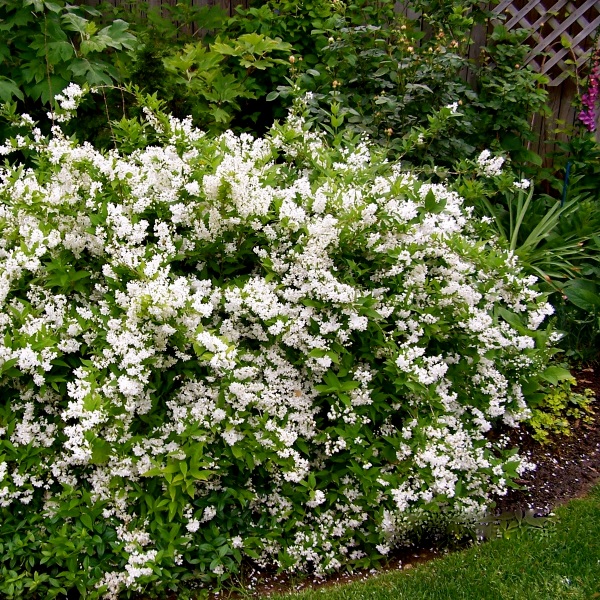
Deutsia pink
Deutia rosea is a fully downy deciduous shrub with pink and white flowers in late spring and early summer. Grows well in partial shade in direct sunlight and prefers medium water levels. The flowers of a rotary form are located in inflorescences in the form of a cymose shield. Drought tolerance is average. It is most picturesque in spring and summer.
This variety grows in soils ranging from pH5 (very acid ranges from 0 to 5.1) to pH8 (slightly alkaline ranges from 7.6 to 8). It is adapted to chalk, clay, loam, sandy loam, peat, sandy clay, sandy loam and sandy loam soils. Prefers fertile soil.
The rounded bush can reach a height of one meter and extends to about the same length. The process of reaching maximum height often takes 6 to 10 years.
The pointed leaves retain their color in winter and summer.
The main method of propagation is cuttings. 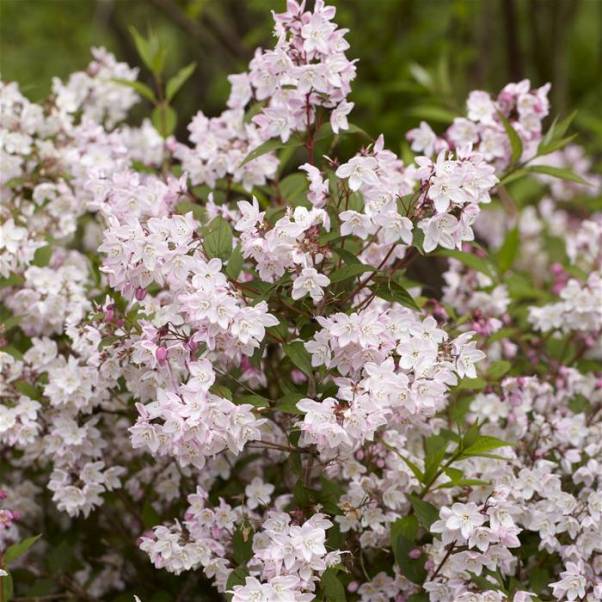
Hybrid action whitest
Snow-white inflorescences of the whitest action reach 12 centimeters, double flowers reach three centimeters in diameter. The period of active flowering is June-July. Subject to all conditions for care, the plant can bloom and maintain a beautiful appearance from 20 to 50 years. It grows very quickly up to two meters. 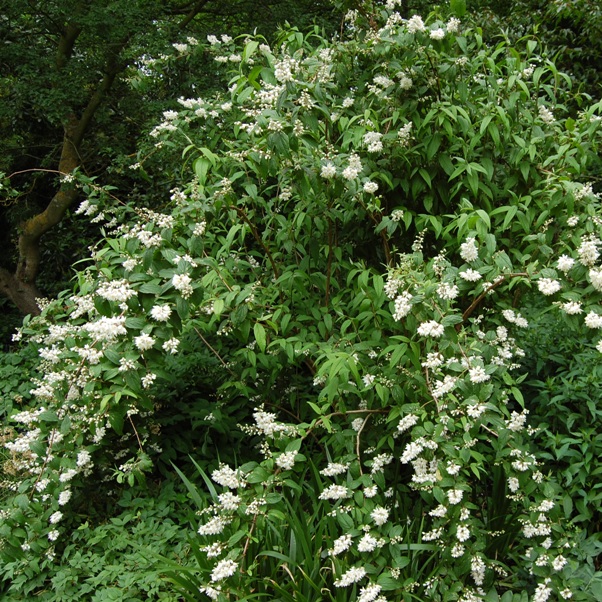
Hybrid action graceful
Deytion graceful is a shrub with opposite simple leaves and slender curved stems. White flowers ripen in spring and summer. Also known as the slender hybrid action and is native to Japan where it blooms in April-May.
The plant grows up to two meters, but at the same time takes on a bulk form and usually extends to one and a half meters.
The slender bush has a greenish-brown with yellow accents shade of oval-shaped leaves 10 by 4 centimeters. They are smooth and thin with a pale green upper surface and smooth, almost snow-white lower ones. For two weeks in April or May, these shrubs are covered with snow-white racemes of cupped flowers. Pure white flowers on background beautiful green foliage makes the bush especially attractive to the eye - it catches the eye and spreads a delicate and fragrant smell.
This crop grows best in fertile, well-drained soil. Action is not picky about the level of soil acidity. Rarely exposed to diseases and various pests, but sometimes aphids attack and leaf spotting can occur.
There is a chance of developing dead wood and often looks soiled. Heavy pruning right after flowering keeps them looking good. The sun is full; humidity - medium; propagation - cuttings in warm weather. 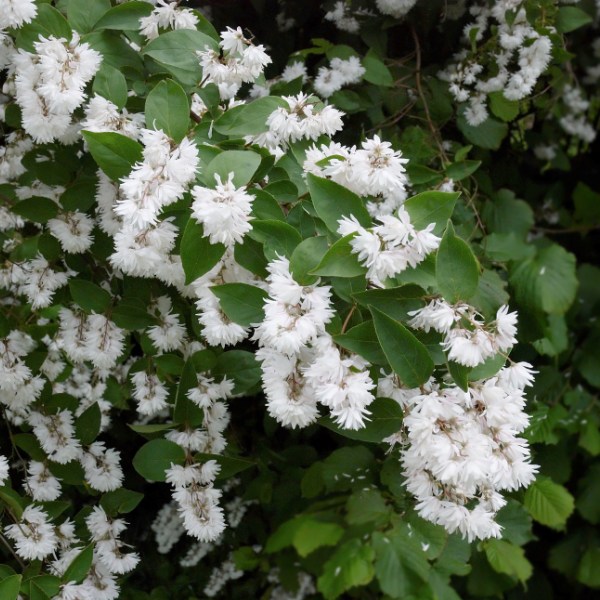
Rough action is great
Magnificent deutsia is a hybrid of rough deutsia and vilmorena deutsia. Most often, the shrub reaches a height of 2-2.5 meters. Under the weight of the inflorescences, the shrub often sinks to the ground. The inflorescences are pinkish-white in color and will delight you for two to three weeks. Unlike its counterparts, the magnificent action prefers a place in the shade, for example, under a large canopy of trees. The flower will receive its magnificent appearance in full force with a sufficient level of humidity and diffused light from the sun. When planting an action, do not forget to prepare good drainage, as it really does not like excessive moisture and salt in the soil.
You can use the plant in apartments in the city, as the flower calmly tolerates gas and smoke, without which a modern city cannot exist.
Action hybrid strawberry fields
Action hybrid strawberry fields is fluffy deciduous shrub with exfoliation of the bark. There are also simple, opposite ovate leaves and flowers in the form of a conical panicle. The petals of the flowers are quite wide, 2.5 centimeters each, raspberry outside and pale pink inside. Arranged in the form of terminal or axillary clusters, they spread a wonderful aroma over a long distance. Blooms in early summer.
The flower is able to grow normally in partial shade and in full light. When planting, chalk, sand, clay and loam are also added to the soil. Likes high humidity, but prefers well-drained soil. Propagated by coniferous cuttings.
Gardeners suggest planting a plant on the borders of garden plots and near houses. 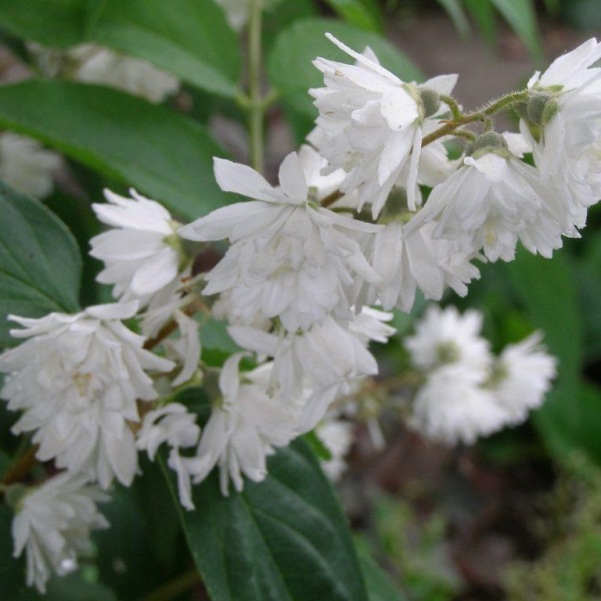
action tourbillon rouge
Deutia tourbillon rouge is part of the Hydrangea family. It has five petals that form a cup-shaped or star-shaped flower. They often have a pronounced aroma during flowering from mid to late summer. More mature plants often have peeling bark.
The flower produces clusters of deep pink in early June with yellow stamens against sharply serrated green leaves. The height of the action can reach one and a half meters.
In order for the plant to actively develop, it is necessary to create conditions - fertile, not too dry soil, the place should be located in full sun. After the end of flowering, it is necessary to trim the shoot from 1/5 to the soil level. 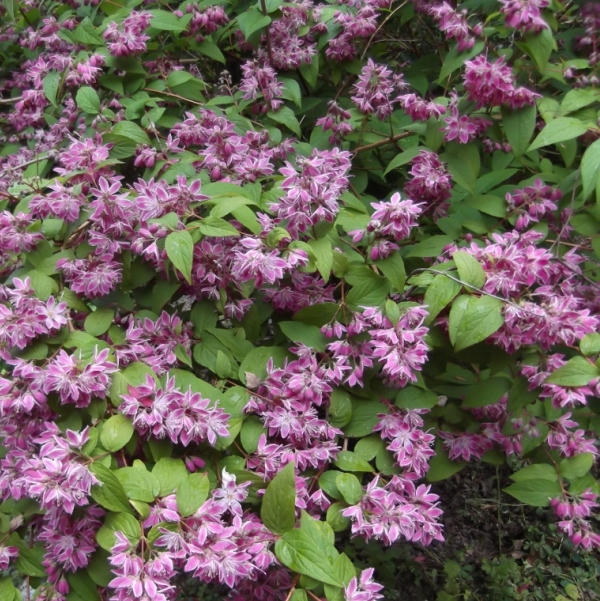
Action of captivity
Action of captivity is a shrub of medium height (one and a half to three meters). Foliage color - green, flowers - white or pink - bloom in late May - early June. Native to East Asia, this low maintenance shrub is perfect for any hell and window sill. Plena is the name for some varieties of deutia with double flowers that are pink on the outside and white on the inside. They form an airy shrub with slightly drooping branches.
The lanceolate leaves are green in color. The plant reaches three meters in height and slightly less in width. Pruning is not required, only if there is such a desire (be sure to carry it out immediately after flowering ends).
Deytion blooms on last year's shoots, so it must definitely form new branches with buds before winter. Well adapted to any soil. Grows well in full sun, but will also grow in shade. 
Action mont rose
Deitia mont rose is a deciduous plant in the form of a medium-sized shrub. The leaves are ovate and have a purplish-pink cone-shaped inflorescence in early summer.
The flower is drought tolerant and grows vertically. In the garden, it will attract bees and butterflies. It is convenient for the garden because of its low performance.
Sort action terry
Deytion terry got its name thanks to double flowers. This is a relatively low plant with a height of 1.5-2 meters. The bush blooms during May June very abundantly. If a large number of flowers bloom, then the trunks of the plant bend. A special picturesque plant is given by inflorescences in the form of a star with petals. white color inside and pink outside.
Action pink pom pom
Action pink pom pom is a flower with straight shoots two to two and a half meters high. It has rough leaves of a dark green hue. The flowers are pink outside and white inside. Inflorescences in the form of a panicle.
Deutsia grows well in moist soil in open sun with humus. Does not tolerate frost. Many gardeners consider this variety one of the most beautiful.
Recently, with the development of landscape design and the prevalence of the trend towards arranging home gardens, exotic plants and shrubs are increasingly found in gardens. Among them, it is impossible to pass by the graceful action. This shrub got its name in the 19th century. It was given by the botanist Carl Thunberg and symbolized the memory of the mayor of Amsterdam, Johann van Deutz.
Deutsia shrub belongs to the hydrangea family. In nature, in the wild, you can find it in East and Southeast Asia and some territories of North America. 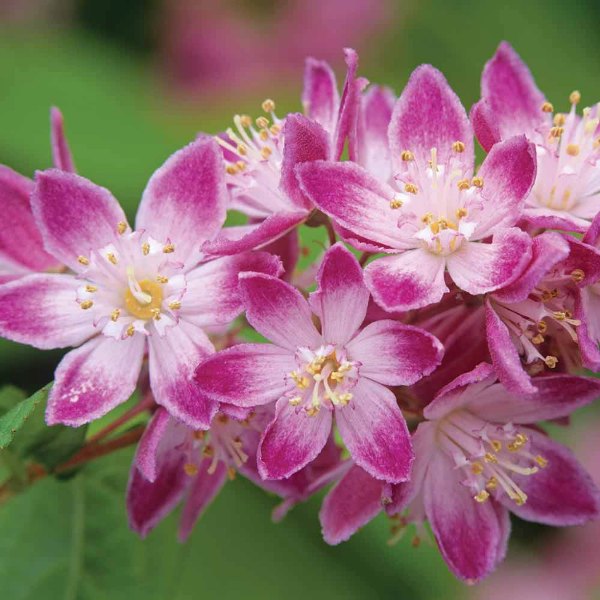
Description of the action and its photo
According to its botanical properties, action is an evergreen shrub. Depending on the variety, it can be either sprawling or upright. The following is short description actions as a botanical culture. Numerous photo actions will help to make a general impression of the shrub, which illustrate the possibilities of its use in landscape design.
In height, individual shrubs, depending on the species, reach from 50 cm to 4 meters. The life span of a flower without a transplant and rejuvenation procedure is approximately 25 years. The leaves, which densely cover the stems, are whole, simple, located opposite each other, of an emerald green hue.
The main and exclusive advantage of the deutsia flower is a long and rich flowering. The beginning of budding falls on the period of late spring - early summer. This parameter largely depends on the climatic conditions of the growing region. As a rule, the action shrub blooms 2 to 3 weeks after the complete convergence of the snowy soil cover.
The flowers on the shrub are white, may be pink or lilac-purple. Without smell. After flowering, a box is tied in which the seeds ripen. It can be propagated by seeds and by cuttings, as well as vegetatively by layering or root offspring.
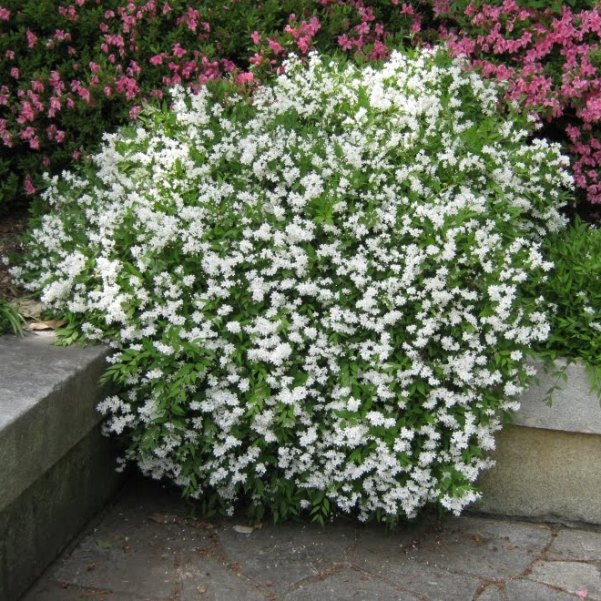
<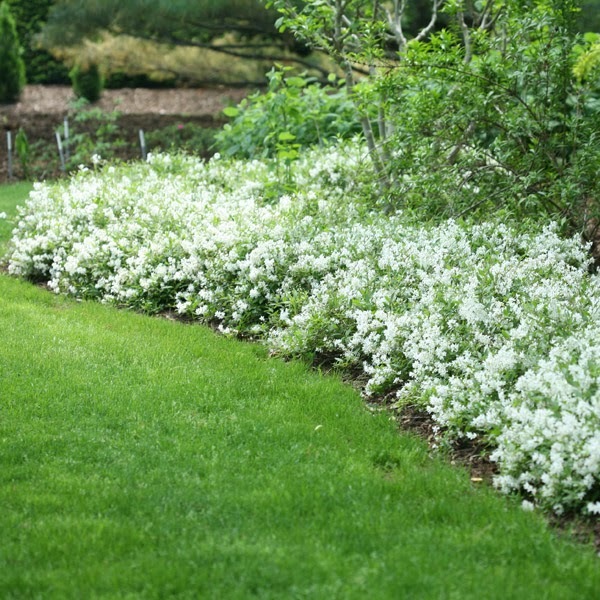
Landing and care action
Properly organized care for the action allows you to form beautiful landscape plantings. The shrub is widely used in planting hedges and creating garden living sculptures.
Before landing the action, it is important to determine the place and mark the site. The distance between individual plantings in group plantings should be at least 250 cm. This place is necessary for the proper development of vegetative shoots and the growth of leaf mass. It is desirable to plant the action in an open area, but on which the direct sun does not fall during the daytime.
To plant the action, dig a hole up to 40 cm deep, fill it with humus, peat and sand in a ratio of 2: 1: 2. The distance between the shoots in this case should be at least 2.5 meters. Planting depth - about 50 cm, the root neck after falling asleep with soil should be located on the same level with the ground. 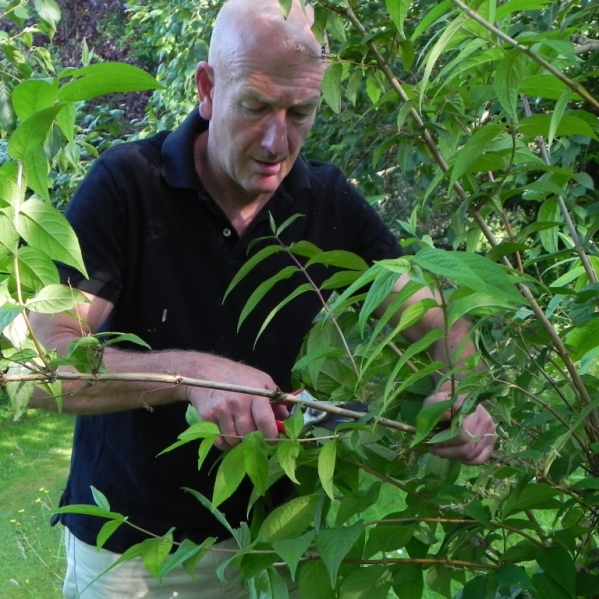
To obtain the result of a lush flowering period, the action plant should be fertilized with organic matter from time to time. For root dressing, you can take any organic matter, which is diluted in warm water in a ratio of 1:10. The application rate for top dressing 1 time in 7 days is about 5 - 6 liters for each bush of action.
Mineral complex fertilizers according to the agricultural technology of cultivating shrubs of action should be applied regularly immediately after spring pruning.
Care of the action includes the proper organization of watering. It is desirable to water 1 - 2 times a month, spending about 10 liters of water for each bush. In hot and dry summers, the amount of watering should be increased to 4-6 times a month, while the amount of water also increases to 20 liters.
In care, the action bush is not capricious and hardy: it is able to endure any city conditions, including smoke and gas resistance.
Deytion is resistant to dry weather, prefers a lighted place and warmth. In cold winters, the above-ground parts of the branches may partially freeze. However, even after severe freezing from frost, its shoots quickly grow again, and the plant is able to bloom in the same year.
Pruning shrub action is required, it is desirable to carry out this procedure every year in spring and autumn. Branches that have faded are pruned to the level of the first strong bud or to the base. From time to time, old shoots are cut out from the shrub, and you can remove the extra ones that thicken the bush.
Near the shrub, weeds should be weeded and the earth loosened to a depth of 25 cm.
Actions bloom on last year's shoots, so the important point is to keep them throughout the winter, otherwise the bush will lose its attractiveness. If your area has snowy winters, you can bend the branches of the plant to the ground. This will be enough to save the plant in the winter. If you have frequent frosts without snow in your area, then you can simply cover the bush with a frame, fill it with dry spruce or pine branches, and cover the upper part with foil. This method is suitable for young plants, and for older and taller plants, you can resort to the following method: tie and wrap with any breathable material, such as a sugar bag.
Common varieties of deytion shrub
In culture, various varieties of deutsia shrubs are cultivated. A variety of varieties of this plant allow you to diversify the landscape design of a personal plot as much as possible at minimal financial cost. After all, among the common varieties of shrub deytion, there are species that are able to form full-fledged hedges and garden sculptures for 1 - 2 vegetative seasons.
Deutzia graceful or slender (Deutzia gracilis)
It grows naturally in northern China and in the highlands of Japan. Accordingly, the graceful action has increased resistance to adverse climatic conditions. Deytion slender is able to withstand prolonged droughts and periods of sharp cooling.
The graceful deutsia bush has a rounded shape, which is ideal for the formation of garden sculpture. With properly organized care, Deutzia gracilis grows up to one and a half meters in length.
The leaves reach six centimeters in length, oblong, pointed, hairy above, and smooth below. In summer, the leaves are light green, and in autumn they turn yellowish.
Flowers are white. Budding begins at the end of May, the flowering period lasts 1 month.

Rough or star action (Deutzia scabra)
In natural landscapes, the rough action can be seen in various parts of Japan and China. This is a unique plant that has a rough surface of the leaf blade. Shrub Deutzia scabra low - up to 2.5 meters. The period of rapid flowering occurs in mid-summer. In the Moscow region, this is usually the end of June or the beginning of July. The leaves are oval, 4-9 cm long, pale green in color. In autumn, they become yellow-brown. The flowers are star-shaped, snow-white, slightly pinkish or light crimson, up to 1.5 cm in diameter.
The shrub is relatively thermophilic and does not tolerate the harsh winters of the Urals and Siberia. In these regions, it is better to grow zoned varieties of rough deutsia. 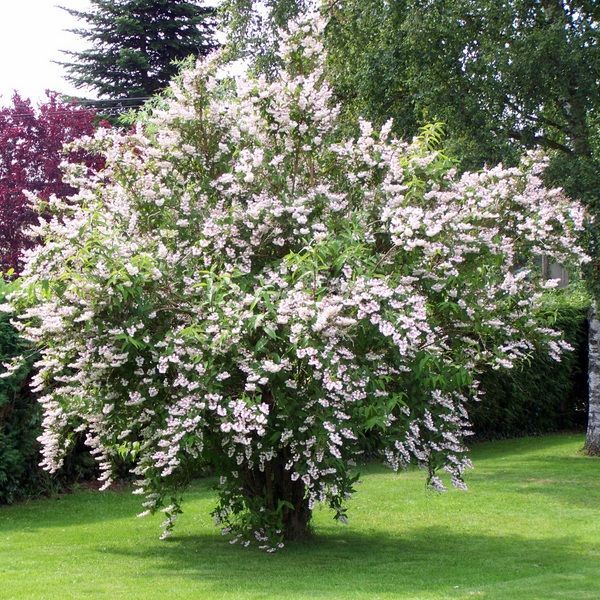
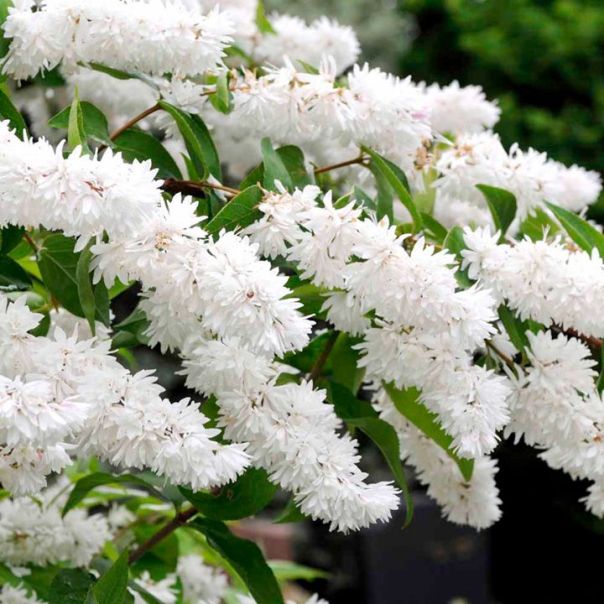
Action rough has a division into species that are more adapted to adverse growing conditions:

Action Pink Pom Pom
Deutsia Pink Pom Pom is a unique variety of this shrub, which was bred at the beginning of this century. The flowers are double, white with a pinkish tint on the outer part of the petals. The leaves are dark green, rough. It has a long flowering period, which begins in early June and can continue with proper care of the action until the end of August.
Look at the photo action of Pink Pom Pom, which fits well into any landscape design: 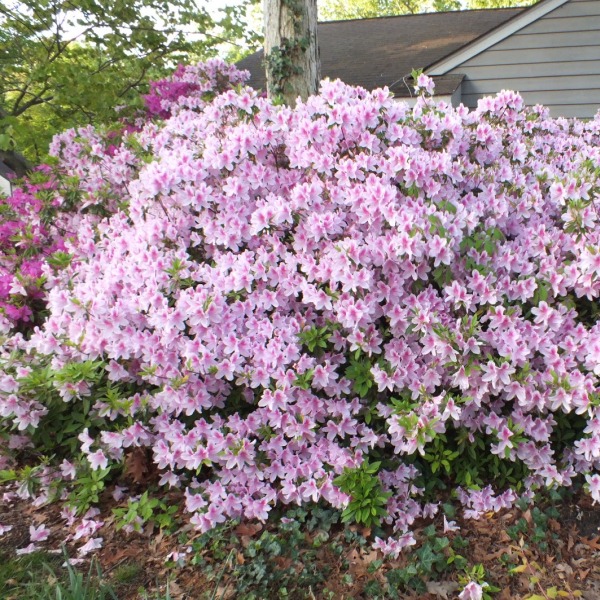

Action hybrid
Obtained from crossing the graceful action and the Amur action. The hybrid action shrub reaches a height of up to 2 meters. Flowers are snow-white. Gives color in the month of July. The leaves are dark green, rough to the touch, turning yellow-red in autumn. Cold resistant. 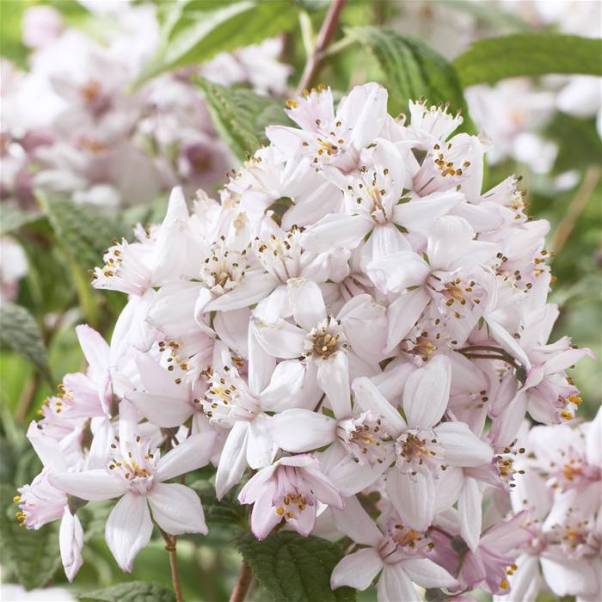
The hybrid action has the following subspecies:

Pink Deutzia (Deutzia rosea)
This is a hybrid between action purple and action graceful. 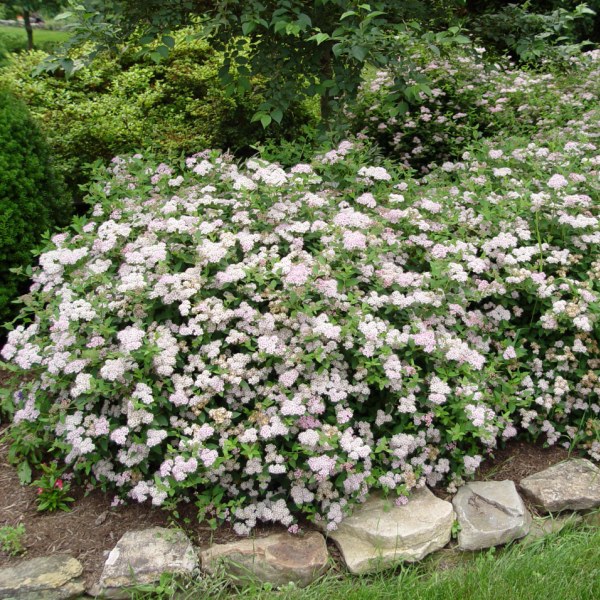
The bush grows in length up to 1 m, not higher. The flowers are shaped like an open bell. The petals are pink at the bottom, and a little lighter at the top.
